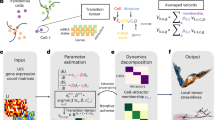Abstract
A prominent hypothesis in embryology is that localized maternal factors are important in specifying cell fate. There are, however, only a few examples of maternal molecules that have been shown to be localized and very little is known about how such factors are physically localized within an egg (for review see ref. 1). Previously, cDNA clones were obtained for a class of localized maternal mRNAs from Xenopus laevis2. These mRNAs are unusual in that they are concentrated at either the animal or vegetal pole of unfertilized eggs. In the present study the synthesis and intracellular distribution of one of them, Vg1, has been examined during oogenesis. The results show that Vg1 mRNA is localized as a crescent at the vegetal pole of mature oocytes. Surprisingly, this mRNA is uniformly distributed in the cytoplasm of immature oocytes. These findings suggest that a single cell, the frog oocyte, has some mechanism for translocating specific RNAs like Vg1. The process that moves Vgl mRNA is evidently a cytoplasmic localization machinery which is not directly coupled to the synthesis of Vgl RNA.
This is a preview of subscription content, access via your institution
Access options
Subscribe to this journal
Receive 51 print issues and online access
$199.00 per year
only $3.90 per issue
Buy this article
- Purchase on Springer Link
- Instant access to full article PDF
Prices may be subject to local taxes which are calculated during checkout
Similar content being viewed by others
References
1. Davidson, E. Gene Activity in Early Development (Academic, New York, 1986). 2. Rebagliati, M., Weeks, D., Harvey, R. & Melton, D. Cell 42, 769–777 (1985). 3. King, M. & Barklis, E. Devl Biol. 112, 203–212 (1985). 4. Jamrich, M., Mahon, J., Gavis, E. & Gall, J. EMBO J. 3, 1939–1943 (1984). 5. Phillips, C. Devl Biol, 109, 299–310 (1985). 6. Gerhart, J. in Biological Regulation and Development (ed. Goldberger, R. F.) 133–293 (Plenum, New York, 1980). 7. Wallace, R. in Oogenesis (eds Biggers, J. D. & Schuetz, A.) (University Park Press, Baltimore, 1972). 8. Danilchik, M. & Gerhart, J. Devl Biol. (in the press). 9. Wallace, R. & Misulovin, Z. Proc. natn. Acad. Sci. U.S.A. 75, 5534–5538 (1978). 10. Heasman, J., Quarmby, J. & Wylie, C. C. Devl Biol. 105, 458–469 (1984). 11. Nieuwkoop, P. Wilhelm Roux Arch, der. Biol. 162, 341–373 (1969). 12. Vincent, J. P., Oster, G. & Gerhart, J. Devl Biol. 113, 484–500 (1986). 13. Coggins, L. J. Cell. Sci. 12, 71–93 (1973). 14. Lawrence, J. & Singer, R. Cell 45, 407–415 (1986). 15. Jeffrey, W., Tomlinson, C. & Brodeur, R. Devl Biol. 99, 408–417 (1983). 16. Kalthoff, K. & Elbetheiha, A. / Embryol. exp. Morph. 97, suppl. 181–196 (1986). 17. Anderson, K. & Nusslein–Volhard, C. Nature 311, 223–227 (1984). 18. Macdonald, P. & Struhl, G. Nature 324, 537–545 (1986). 19. Mlodzik, M. & Gehring, W. Cell 48, 465–478 (1987). 20. Kintner, C. & Melton, D. Development 99, 311–325 (1987). 21. Dumont, J. / Morph. 136, 153–180 (1972). 22. Melton, D. et al. Nucleic Acids. Res. 12, 7035–7056 (1984).
Author information
Authors and Affiliations
Rights and permissions
About this article
Cite this article
Melton, D. Translocation of a localized maternal mRNA to the vegetal pole of Xenopus oocytes. Nature 328, 80–82 (1987). https://doi.org/10.1038/328080a0
Received:
Accepted:
Issue Date:
DOI: https://doi.org/10.1038/328080a0
This article is cited by
-
Dynamics of maternal gene expression in Rhodnius prolixus
Scientific Reports (2022)
-
Asymmetric distribution of biomolecules of maternal origin in the Xenopus laevis egg and their impact on the developmental plan
Scientific Reports (2018)
-
In the right place at the right time: visualizing and understanding mRNA localization
Nature Reviews Molecular Cell Biology (2015)
-
Control of cytoplasmic mRNA localization
Cellular and Molecular Life Sciences (2012)
-
Transcriptome asymmetry within mouse zygotes but not between early embryonic sister blastomeres
The EMBO Journal (2011)
Comments
By submitting a comment you agree to abide by our Terms and Community Guidelines. If you find something abusive or that does not comply with our terms or guidelines please flag it as inappropriate.



